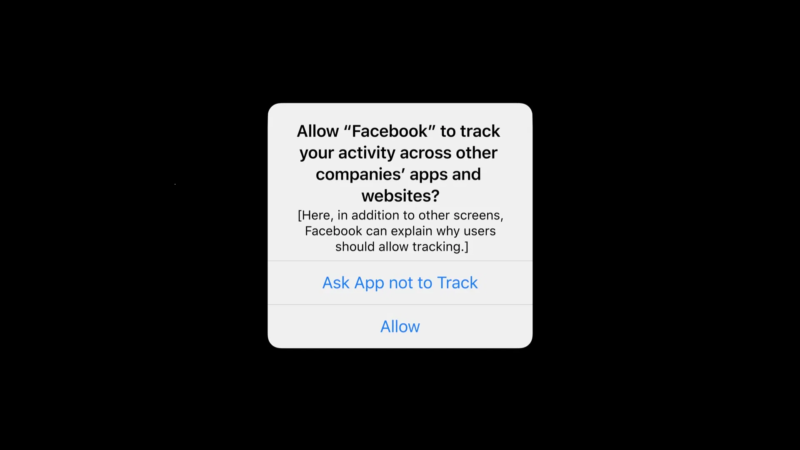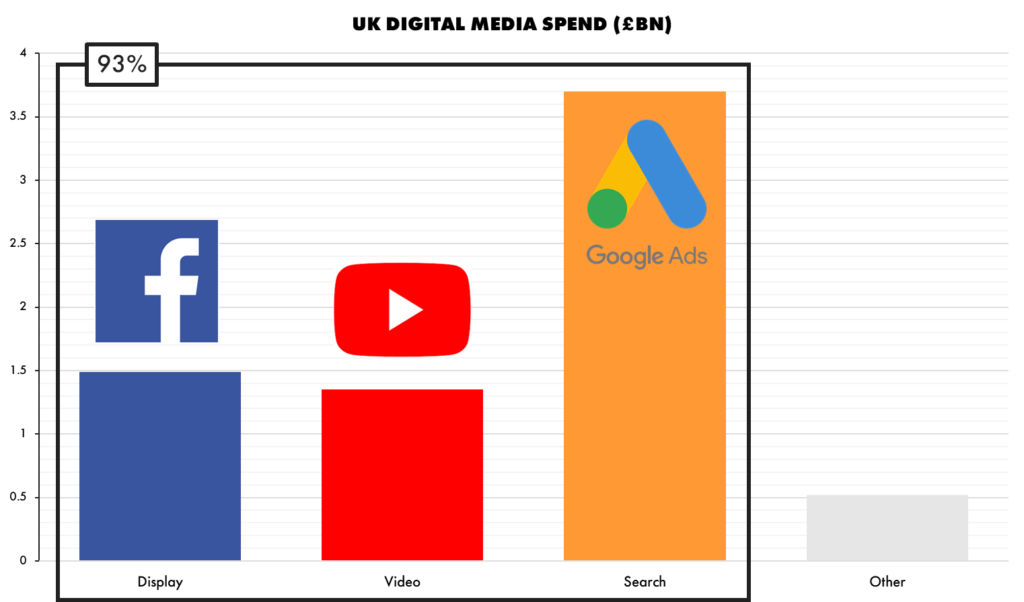IOS, Facebook, Google & Effective 1st Party Customer Acquisition

Apple’s much discussed iOS 14.5 release profoundly changes app marketing data collection with the introduction of a feature called App Tracking Transparency, and has caught the headlines across marketing due to the anticipated opting-out of essentially all the platform’s users from any marketing analytics data. The most affected platform is anticipated to be Facebook, who claim that the feature will have “hard-hitting implications across targeting, optimization, and measuring campaign effectiveness.”
This is critical as Facebook, together with Google, represents 93% of all digital media spend for most UK brands today per the IAB.

Google will themselves follow suit with an Android equivalent in the coming year that is yet even to be specified, such is the pressure to demonstrate and deliver on privacy commitments that we as consumers expect. Their own iOS Apps are not expected to affected to the same extent as Facebook, as they have adapted their tracking to no longer use Apple’s IDFA meaning no alert will need to be shown, however Google is of course a major advertising player just like Facebook and will be affected in the same ways for app tracking where they operate as the Adtech intermediary via Google Mobile Ads and analytics partner with Firebase.
Ultimately, this means that once iOS14.5 is out in the wild, advertisers will struggle to connect app installs, sales, and other more granular metrics to ad campaigns, undermining current approaches to ad performance measurement.
Mobile Privacy Follows the Death of the Cookie

Google itself has prompted a focus on new approaches to analytics by shouting loudly about making changes to Chrome – by far the most popular user-agent in the world – working on a variety of alternative tracking solutions that decouple analytics’ reliance on cookies. Recently Google promoted an approach called Federated Learning of Cohorts (FLoC) that would – like all options they will present – be exclusive to Chrome and another area for marketers to address alongside iOS.
In many respects this is the same challenge as the App Tracking Transparency challenge, writ large on the landscape of the wider web instead of just the app analytics ecosystem. And this area of analytics is dominated by – once again – Google with an estimated 84.2% marketshare, and Adobe who although tiny in comparative install base, have a significant position for high volume websites thanks to their enterprise credentials and legacy.

Looking at the long game from Google it is tempting to speculate that Google’s shifting position on Chrome data measurement mirrors Apple’s privacy position and may create a market for second party data agreements between the two to allow back end data analytics across the two ecosystems – App and Web – that are comprehensive, respectful of privacy controls and legislation, and robust based on log level data rather than the flakier cookie system approach. A win for consumers surely?
However, hardened Apple and Google watchers will know that it is difficult to see an agreement on private data sharing between these fierce competitors, not least because of the reputational hit Apple would take for being seen to get into bed on privacy with the somewhat tainted Google brand who, to pick just one example, in 2019 was creating fake pageviews to enable user tracking when explicitly asked not to to enable selling on of personal information.
Which leaves us with a more fragmented landscape today – one with two major app data ecosystems that need to be bridged – Apple and Android – and a wild web that is also fragmented with the decline of the cookie, a dominant analytics provider who also happens to be marking their own homework as one of the largest advertising partners in the world in Google, and yet more proprietary data ecosystems primed to replace the cookie in its dominant browser Chrome. Oh, and Amazon are increasingly taking share for ecommerce, have their own huge audience, also operate in total silo, and launched their own AdTech into the increasingly packed programmatic DSP space in 2019.
What is a brand to do to enable measurement and effectiveness of digital performance?
The Cookie Was Broken Decades Ago: Embrace Probabilities
The good news is that when you get into the business of analysing raw web and app clickstream data you will realise that your analytics data was already pretty broken. If this is news to you: I am sorry to be the bearer of bad news, but it is true, your analytics is likely 80% broken data – partial session that represent only a fragment of a customer’s experience.

A Guide to Marketing Optimisation
Your analytics data integrity is built on shifting sand that has never stood up to scrutiny.
As a marketing professional that started out optimising for then important search players like Dogpile and Ask Jeeves, and a web developer from back when hardly anyone had internet connections and you booked a slot on university computers to access your email, I’ve always had an awareness that the underlying metrics of the web were fundamentally piecemeal.
The promise of cookie driven analytics such as that of the then new kid on the block Urchin, now Google Analytics, was an ability to see beyond your own web server analytics – the raw hits and logfiles a server generates in the operation of actually generating a web page when requested by the user-agent. This was to enable understanding if the person sitting behind the desktop – or increasingly the laptop, then mobile – has previously visited, and to stitch together those sessions into a single ‘visit’ that could be optimized and matched back to advertising campaigns – almost exclusively a Google Search or Display Ad – with unique campaign identifiers.
Today, most marketers are aware that their analytics data is – if not fundamentally broken – then certainly not fulfilling on the promise of representing a complete user journey over more than one or two – at best – sessions.
Attribution is the symptom of this broken ecosystem.
In 2013, when QC seriously started looking at the data being used to drive marketing decision making for our enterprise customers, we quickly concluded that a different approach to building a picture of a customer’s journey would be essential to any attempt to then attribute across that journey and allow marketers to spend more efficiently and effectively and capture new customers at a lower overall cost per acquisition (CPA).
Ultimately, we ended up developing Corvidae on probabilistic foundations – using proprietary predictive modelling techniques to build an analytics rebuilding engine that ignores the cookie and looks instead at determining the probability that a second session is a continuation of a first, and that a third session was a continuation of the second, and so on. This is hugely computationally expensive when you consider that for the likes of Tesco and BT – the customers QC engage with for our performance marketing work – there would be tens of millions of such sessions every day.
Thanks to developments in Machine Learning, we can today offer that powerful rebuilding at a fraction of the cost, which allowed us to roll the product out last year as a standalone platform that is capable of and provably able to look across all data silos and consolidate sessions into single user journeys with more than 85% accuracy, radically improving our ability to then attribute revenue across the engagements encountered in those journeys with marketing collateral, web pages, or even offline TV & Radio spots.
What does all this have to do with iOS 14.5’s App Tracking Transparency or Google’s FLoC?
Ultimately they are simply now data silos in the same way that the wider web’s cookie data turned out to be siloed from our Web Analytics when we began to try attributing it. Advertisers today need to build a measurement framework on similar probabilistic foundations to move forward and allow effective marketing analytics and optimisation.
Updating your Facebook app SDKs – and Google’s – to ensure the 1st party data you are receiving is as good as it can be, and integrating a web analytics solution like Covidae will enable deployment of first party pixels that are ‘containerised’ and therefore unaffected by the removal of cookie data and do not require new data joining techniques like FLoC to map across into other ecosystems.
The future is probabilistic, built on machine learning and sophisticated deep learning models that better understand and map customer behaviour across the modern data ecosystem. 2021 is the year to embrace that change.
Own your marketing data & simplify your tech stack.
Have you read?
I have worked in SEO for 12+ years and I’ve seen the landscape shift a dozen times over. But the rollout of generative search engines (GSEs) feels like the biggest...
As you will have likely seen, last week Google released the March 2024 Core Algorithm Update. With it, comes a host of changes aiming to improve the quality of ranking...
After a year of seemingly constant Google core updates and the increasingly widespread usage of AI, the SEO landscape is changing more quickly than ever. With this rapid pace of...



